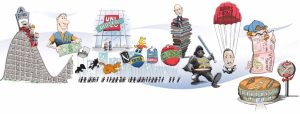Each year in retail brings success and failure, surprise and sadness, but most of all comes change and transition.
Macy’s (Cincinnati) captured national attention this past summer when the 158-year-old retail brand announced it would close 100 stores.
Amid public speculation, the retailer insisted it was “just smart business.” But some say cultural historians might look back at this year as the beginning of the end, not only for the department store model, but also for the enclosed shopping malls that had represented retail expansion in the second half of the 20th Century.
Walmart (Bentonville, Ark.) said it was “just smart business,” too, to raise employees’ wages. Early returns suggest it was smart, indeed.
There were other developments during 2016, in the form of closings and bankruptcies, retirements and new ventures – the usual annual retail bouillabaisse.
But Macy’s created the year’s biggest buzz. While voting in the U.K. and U.S. dominated the headlines, Macy’s exit was almost as note-worthy as Brexit.
Advertisement
There used to be a Macy’s here.

In August, Macy’s announced it would be closing 100 stores by early next year. Too many of its locations were losing money. Too many consumers were shopping online. Not enough of those online shoppers were going to Macys.com.
For one of the last remaining department store powerhouses, one which has been trying desperately to keep the department store concept alive and meaningful, it was a troubling bit of writing on the wall.
Macy’s Chair Terry Lundgren said the retailer would concentrate on its best-performing locations and on its online operations. But it raised questions as to which direction classic physical retailing was heading, and whether the nation’s malls would soon be following suit.
Advertisement
Closed for the holiday.

In October, Mall of America (Bloomington, Minn.) announced it would officially be closed on Thanksgiving Day, though it said its retail tenants could choose to be open if they wanted. Within a few days, Costco and Home Depot said that they, too, would remain shut for the holiday.
By the end of the month, TheBlackFriday.com was posting updated lists of retailers who had announced they would follow suit: American Girl, Crate & Barrel, IKEA, Lowe’s, REI, Marshall’s, Neiman Marcus, Nordstrom, Staples and T.J. Maxx.
Many said they were closing “out of respect for employees and their families.” But Slate.com had a different take: “Retailers have officially lost the so-called ‘war on Thanksgiving.’ ” Shoppers are still shopping on the holiday – they’re just doing it from home.
Advertisement
You get what you pay for.

In January, Walmart announced it would raise the pay scale for its more than 1 million U.S. store workers to a minimum of $10 per hour. (The average hourly pay will be upwards of $13, the company reports.)
The retailer said it was also reconfiguring its policies on benefits such as paid time off, sick leave, holidays and vacation days, as well as expanding its employee training program.
What did the scourge of organized labor have in mind? Walmart CEO Doug McMillon said it was a strategic investment to boost morale and improve performance. In October, the retailer reported that comparable U.S. sales rose 1.6 percent, higher than the 1 percent expected by Consensus Metrix (Wayne, N.J.), according to Fortune magazine. Also, 75 percent of stores were hitting their targeted customer-service ratings, he said.
Fast fashion slows down.

In June, Uniqlo – the Japanese fast-fashion retailer that has been courting the American market over the past few years – announced it would close five of its mall-based U.S. stores and scale back its aggressive new store plans.
Gone are Uniqlo stores in the suburban markets of Danbury, Conn.; Cherry Hill, N.J.; Willow Grove, Pa.; Northridge, Calif.; and the New York borough of Staten Island. Additionally, its plan for adding 15 new stores each year has been scaled back to five per year.
Uniqlo’s initial campaign was for 200 U.S. stores by 2020. So what happened? Too much mall presence. “The brand penetration in big cities such as New York, San Francisco and Chicago – where we will open a new store – is good, but not in the suburbs,” Uniqlo CEO Tadashi Yanai recently told Fast Retailing.
Well, they were being called “The Gap of Japan.”
We’ve read this book before.

Amazon (Seattle) went into the book-selling business – the brick-and-mortar kind. Throughout 2016, the e-tailing giant announced more and more physical locations: Seattle, San Diego, Chicago, New York and Portland, Ore.
Was this Jeff Bezos’ last laugh at the retail world? After all, books were his initial foray into e-commerce, putting booksellers like Borders, Waldenbooks and Doubleday out of business and seriously crippling Barnes & Noble.
The job section of Amazon’s own website says the retailer is applying “20 years of online bookselling experience to build a store that integrates the benefits of offline and online book shopping.”
Or, as someone else said this year, “Who knows how the system works better than me?”
The final chapter.

In April, Leonard Riggio – who, in 1971, bought a small downtown bookstore on the New York University campus called Barnes & Noble and turned it into a master class on how to revolutionize retail – announced his retirement.
In building an international empire, Riggio did more than simply change the way books were sold. He rewrote many retail rules, turning Barnes & Noble into one of the world’s first category-killing superstores and practically invented the idea of “the third space” – a store as a refuge for reading or drinking coffee or browsing through magazines, somewhere between home and work.
A bad day for teenage fantasies.

In April, Victoria’s Secret announced it would cease publication of its picturesque catalog after 40 years of producing and mailing up to 300 million copies a year.
Parent company L Brands (Columbus, Ohio) explained the decision would save up to $150 million a year. It also revealed that it had run a test in the fourth quarter of 2015, reducing the catalog’s release by 40 percent, and sales hadn’t suffered. And it said environmental activists had pleaded with the company to look at the impacts of printing and mailing so many copies.
Try telling that to 2 million or so adolescents. Or have they, too, already turned to the Internet?
The empire strikes back? Or out?

Walmart began the year by announcing it would be closing 269 stores – 154 in the U.S.
The news immediately sparked some “beginning of the end” conjecture, proclaiming that consumers don’t want superstores anymore, or that Walmart is too big – too rigid, too top heavy, too old – to change with the times. It went to war with Amazon, and seemingly, Amazon won. If Walmart can’t survive, they said, what are the chances for the rest of brick-and-mortar retail?
But tolling the death knell was probably way too premature. Walmart is still a half-trillion-dollar global powerhouse. It also announced it would open more than 350 new stores around the world. Other retailers stumble and recover, reexamining and redirecting strategies. It’s just that when Walmart does anything, the reverberations are enormous; the “evil empire’s” price of success.
You don’t know hospitality from Shinola.

Tom Kartsotis, who turned Shinola from a former shoe polish brand (and a commentary on what you don’t know) into a hip luxury watch and leather goods retailer, is building a downtown hotel on his brand’s home turf of Detroit.
The 130-room boutique Shinola Hotel will open in 2018 in the city’s emerging Woodward Avenue shopping district. Andrew Carmellini’s NoHo Hospitality Group will also be involved.
There’s a trend going on. West Elm, the San Francisco-based home furnishings subsidiary of Williams-Sonoma, announced plans to open at least five U.S. hotels by 2018, in cities like Indianapolis and (well, look here!) Detroit. High-end at mid-market pricing, said the company, just like its merchandise.
European luxury brands Baccarat and Armani have already opened their own hotels internationally. It’s the latest in customer service: Give ’em a place to sleep.
The many lives of Aéropostale.

Aéropostale (New York) is hardly the first company to rise and fall, be forced into bankruptcy reorganization, and then reemerge with a new business plan.
But the struggling specialty apparel retailer really compressed the process.
In January, Aéropostale was told it would be delisted by the New York Stock Exchange after more than 30 consecutive days when its price fell below $1. In May, it filed for bankruptcy and said it would close 113 of its 780 stores, including the Times Square location in New York. By September, it was out of bankruptcy, bought by a consortium headed by mall owners Simon Property Group and General Growth Properties, and would move forward with 229 operating units. All in one year.
But what a year!
Illustrations: Don Heyl, Cincinnati


 Photo Gallery3 days ago
Photo Gallery3 days ago
 Headlines2 weeks ago
Headlines2 weeks ago
 Sector Spotlight2 weeks ago
Sector Spotlight2 weeks ago
 Headlines1 week ago
Headlines1 week ago
 Headlines5 days ago
Headlines5 days ago
 Headlines2 weeks ago
Headlines2 weeks ago
 Designer Dozen1 week ago
Designer Dozen1 week ago
 Headlines3 days ago
Headlines3 days ago


























